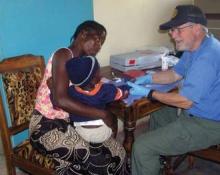In the early 2000s, I was a practicing pediatrician in my hometown of Lincoln, Neb., involved in teaching medical students, and I was looking for new challenges as I neared retirement age.
I attended the American Academy of Pediatrics’ Section on International Child Health (SOICH) annual meeting and signed up for their listserv, which alerts members of news and events in international pediatrics. Dr. Donna Staton, then–SOICH chair, notified me about the opportunity for a Yale scholarship to volunteer in a developing country; I was awarded the scholarship in 2003 and spent 6 weeks in the children’s ward at Livingstone General Hospital in Zambia, Africa. This was an incredible experience, but much of what I encountered were preventable conditions (anemia, malaria, protein/calorie malnutrition, etc.). I realized other strategies were needed if there was to be a positive impact on child health.
When Rotary District 5650 officers heard of my Zambian experience, they encouraged me to develop an international project that could be funded in part by matching grants. Our work with Rotary – an organization of business and professional leaders that provides humanitarian service – has evolved over the past 8 years into a three-tiered project: drilling new bore holes in rural villages; creating associated gardens; and a health and nutrition education project funded by a 3-year I-CATCH (International Community Access to Child Health, a program of the AAP).
Zambia is a developing country whose people have a life expectancy of around 50 years, a mortality rate of 14% for children under age 5 years, and a yearly per capita income of about $4 per day, yet it is safe and the improving economy yields promise for alleviating poverty.
The Rotary Foundation Matching Grant is funding wells and gardens, which are developed by Sustainability Through Agriculture and Micro-Enterprises –the SAM Project – a Canadian philanthropic organization. These commercial gardens not only provide income for the villagers but also support nutrition and health projects.
During our visit in 2009, neighborhood health workers (NHW) Malvina Simulwi and Patson Sibibi, requested our help in enhancing their skills and improving the health in the Nsongwe Village in Zambia. Our I-CATCH grant helped my nursing colleague, Dorothy Zimmerman, and me to teach fundamental skills to these eager NHWs. Then we taught them to evaluate the growth and improve the diets of 150 children in the village. Of those evaluated, a third were anemic and a similar number were stunted or underweight. However, many were growing well, and we discovered that these mothers and their children were using a practice known as "Positive Deviance" promoted by nutritionists at Tufts University, Boston.
We found that, initially, infants beginning complementary foods around age 6 months were given primarily maize porridge, lacking in complete protein and other essential nutrients. Mothers whose children were growing normally often gave them eggs, ground nuts, and other nutrient-rich foods. Following the evaluations, we sponsored a meeting with a group of 20 mothers whose children were equally divided into those growing well and those who were underweight/stunted. We followed-up with a cooking class demonstrating the preparation of a dish that combined an indigenous nut and plants, which provided some of the nutrients lacking in the traditional diet. One mother commented that "We eat these nuts, but we didn’t realize they were so good for you." We used the Internet to access a Zambian government document that listed the nutritional values of the indigenous foods. Thus, by combining traditional practices with science, we hope to have a positive impact on the well-being of the children in these rural villages.
Our experience this year was extremely rewarding as our NHW colleagues rapidly learned to take vital signs, including blood pressure readings, as well as learning a brief physical exam called "Look, Listen, and Feel." Although the Zambian Health Ministry requires that the NHW screen all villagers prior to receiving a referral to a clinic or hospital, these bright and dedicated workers had received only minimal medical training. The mothers responses to these exams were good, saying "This is something new, no one has examined our children before," even though there has been an active clinic for children under 5 years at the village. But these services had been limited to weighing children and monitoring their weight. Equipment such as thermometers and scales were provided by the Beatrice (Neb.) Community Hospital and BryanLGH Hospital and St. Elizabeth Regional Hospital in Lincoln, Neb., as well as from I-CATCH funding.




